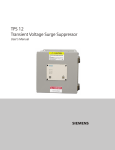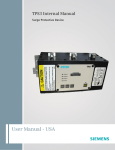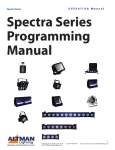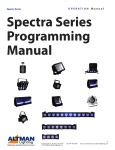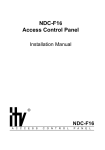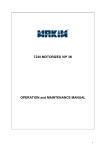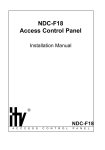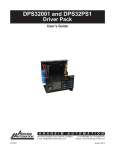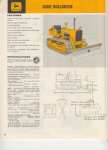Download DRIVE ISOLATION TRANSFORMER TYPE: T
Transcript
MTE Corporation DRIVE ISOLATION TRANSFORMER TYPE: T USER MANUAL PART NO. INSTR - 017 REL. 031112 Instructions for the Safe Handling, Installation, Operation and Maintenance of Ventilated Dry-Type Transformers Table of Contents Paragraph Page General ........................................................................................................................................................1 ...................... 2 Inspection upon Receipt ...........................................................................................................................2 ....................... 2 Handling .....................................................................................................................................................3 .....................2-3 Storage ........................................................................................................................................................4 ...................... 3 Application .................................................................................................................................................5 ....................... 3 Installation ..................................................................................................................................................6 ...................... 3 Accessibility ................................................................................................................................... 6.1 ..................... 3 Ventilation ...................................................................................................................................... 6.2 ..................... 3 Sound .............................................................................................................................................. 6.3 .................... 3 Environmental Conditions ............................................................................................................ 6.4 ..................... 4 Outdoor Installation ...................................................................................................................... 6.5 ..................... 4 Connections ...............................................................................................................................................7 ....................... 4 Lighting Tap Applications ............................................................................................................ 7.1 ..................... 4 Grounding ...................................................................................................................................... 7.2 ..................... 4 Before Energizing .....................................................................................................................................8 ....................... 4 Operation ....................................................................................................................................................9 .....................4-5 Maintenance .............................................................................................................................................. 10 ..................... 5 Drying ......................................................................................................................................................... 11 ...................... 5 IMPORTANT: The information contained herein is general in nature and is not intended for specific application purposes nor is it intended as a training manual for unqualified personnel. It does not relieve the user of responsibility to use sound practices in application, installation, operation and maintenance of the equipment purchased or in personnel safety precautions. Should a conflict arise between the general information contained in this publication and the contents of drawings or supplementary material or both, the latter shall take precedence. 1. General 2. Inspection Upon Receipt The successful and safe operation of dry-type transformers is dependent upon proper handling, installation, and maintenance. Neglecting certain fundamental installation and maintenance requirements may lead to personal injury and the failure and loss of the transformer as well as damage to other property. Immediately upon receipt of the shipment, identify all units and check them against the shipping list. Make a visual examination to detect any damage which may have been incurred during transit. If any damage is discovered, file a claim immediately with the carrier and send notice of the extent of damage to the local sales office, giving complete identification, carrier's name and railroad car number if the shipment was made by rail. The information will enable the company to supply necessary data in support of claim. WARNING: DANGER! There is a hazard of electric shock or burn whenever working in or around electrical equipment. Power must be off before working inside a transformer. Each transformer is assembled and given complete tests at the factory, after which it is inspected and packed for shipment. 2 3. Handling All transformers are bolted to a wooden skid for shipment. All units can be handled with a forklift truck. Transformers are provided with lifting eyes at the top of the enclosure for two point lift (see Figure 1) or at the base for four point lift or by taking off the cover and using the lifting means on the transformer. The use of a spreader is generally recommended. Units are not designed for laying on their ends or sides. If it is necessary to handle ventilated Dry-Type Transformers outdoors during inclement weather, they should be thoroughly protected against the entrance of moisture. CAUTION: Never attempt to lift a transformer from points other than the lifting eyes provided. 6.1 Accessibility 4. Storage Any transformer which is not installed and energized immediately should be stored in a clean dry space having a uniform temperature to prevent condensation. Preferably, it should be stored in a heated building having adequate air circulation and protected from cement, plaster, paint, dirt and water. The protective plastic wrapping should be left in place during storage. 5. Application Insulation systems are classified by industry standards in accordance with the following rating system Insulation Systems Classification Ambient 40° C 40° C 40° C 40° C +Winding Rise 55° C 80° C 115° C 150° C CAUTION: Installation and maintenance should be performed only by experienced and qualified personnel. No attempt should ever be made to change the taps, or make cable connections while the transformer is energized. To maintain safe operating conditions, do not remove the panels or cover while the transformer is in operation. +Hot Spot 10° C 30° C 30° C 30° C Temp. =Class 105° C 150° C 185° C 220° C These transformers are designed using a 220° C insulation system, regardless of the requested temperature rise of the transformer. Transformers with a standard 150° C winding temperature rise operate at full load with a maximum 50° C / 122° F temperature rise on the surface areas of the enclosure. As an example, with a 40° C ambient, the maximum measured enclosure surface temperature would be 90° C / 194° F. 6. Installation Dry-Type Transformers are for indoor use unless the enclosure is specifically designed for outdoor weatherproof service. They are cooled by means of free circulation of air, the maximum ambient temperature of which should not exceed 40° C (104° F). Damage may result if the air flow is restricted, or if the transformer is loaded beyond its rated capacity. Due to various building and room constructions, it is recommended that applicable codes be followed. Factors which should be kept in mind when locating DryType Transformers are: personnel safety, accessibility, ventilation, locations affecting sound level, and environmental conditions. Installations should be made in an area reasonably free from dust, moisture, chemical and corrosive vapors or fumes. Dry-Type Transformers must be installed in an upright position. Dry-Type Transformers should be located in an area where the transformer can be inspected at any time. The wiring compartment should be easily accessible at all times. It is a requirement of the National Electrical Code that sufficient access and working space shall be provided and maintained about all electrical equipment to permit the ready and safe operation and maintenance of such equipment. Refer to the requirements of the NEC for the particular installation involved. The working space required by this standard should not be used as a passageway or for storage. When normally enclosed live parts are exposed for inspection or servicing, the working space, if adjacent to a passageway or general open space where other work is carried on, should be guarded. 6.2 Ventilation Adequate ventilation is essential for the proper cooling of Dry-Type Transformers and clean air is desirable. Filtered air may reduce maintenance if a location presents a particular problem. The ventilating screens and openings in the transformers are designed to provide adequate ventilation for the transformer and should not be restricted in any way. Transformers rated through 51 KVA should be located at least 4 inches away from walls or other obstructions to allow free circulation of air through the ventilation openings. For units above 51 KVA, spacing should be a minimum of 6 inches. If the transformer is located in a small room, ventilation should be provided to maintain an average of 30° C (86° F) ambient not to exceed 40° C (104° F) in any 24-hour period. 6.3 Sound Audible sound may be a factor, and consideration should be given to the specific location and method of installation of the transformer keeping in mind the following suggestions: • Mount the transformer away from corners of walls or ceilings. • Provide flexible conduit to make the connection to the transformer. • Use sound absorbing material on the walls and ceiling. • Locate the transformer as far as practical from areas where high sound levels are undesirable. 3 6.4 Environmental Conditions 7.1 Lighting Tap Applications Ventilated Dry-Type Transformers are normally designed for installation in indoors applications only. They may be installed outdoors if they are of outdoor construction.. Transformers should be installed in locations where the ambient atmosphere is free from unusual chemical fumes or dust. Most transformers with 240 volt delta secondaries have a 120 volt single-phase lighting tap. The maximum singlephase 120 volt load should not exceed 10% of the threephase KVA rating. The load should also be balanced at 5% maximum between terminals X1 to X4 and 5% between terminals X2 to X4. The three-phase KVA must also be reduced by 30% of the nameplate rating. 6.5 Outdoor Installation 7.2 Grounding The same care must be taken when selecting a location for outdoor Dry-Type Transformers. Walls may be built around the transformer if proper care is taken to allow sufficient air flow. It is recommended that a suitable concrete pad with adequate drainage be used for the outdoor location. Pad should be approximately 4" above ground level. The hole plugs supplied with some outdoor units must be in place in each end of the unit to prevent moisture from entering the enclosure (Figure 1). All core and coil structures have a flexible ground connection to the enclosure which ensures that all dead metal parts have the same potential. The transformer enclosure should be solidly grounded so that no danger will exist for operating or maintenance personnel. A transformer ground stud or ground bus is provided for the customer's ground connections. The grounding conductor for a transformer should have a current-carrying capacity in accordance with the National Electrical Code. CAUTION: Transformers are not tamper proof. The location of the transformer must be away from children and all unauthorized personnel. Failure to do so may result in serious injury. 8. Before Energizing 7. Connections All cable entrances should be into the terminal compartment located in the lower transformer enclosure. When making cable connections or changing taps, always use two wrenches when tightening or loosening bolted connections to prevent distortion or damage. The terminal connections are either bare aluminum, tin plated aluminum or copper. The aluminum surfaces are furnished with a protective coating to prevent oxidation. The unused tap connections are also furnished with a protective coating. This coating should remain intact until these connection points are needed. CAUTION: Make only those connections shown on the nameplate or connection diagram. Before energizing, check all tap jumpers for proper locations, and all bolted connections for tightness. If it is necessary to change taps or assemble a lug to a connection point, gently scrape coating from new connection surface using a sharp knife. Apply a light coating of grease from the tap jumper pad to the scraped surface and tighten connection using two wrenches as described above. Refer to Figure 3, Page 8 for instructions for the installation of cable lugs. Care must be taken to place all leads to the same load, or from the supply source through one knockout so that no part of the transformer case is positioned between such leads. NOTE: After installation of connectors and cabling, a minimum of 1" clearance must be maintained from energized parts to all case parts. 4 Before energizing the transformer, loosen or remove all shipping hardware, and store for future use. If it is desired to change location of the transformer at a future date, reinstall all shipping hardware as shown in Figure 1. If shipping hardware is left in place, excessive enclosure vibration will increase the sound level. Check all tap jumpers for proper locations, and all bolted connections for tightness, using two wrenches as described in Section 7. After installation is completed, remove any debris from the bottom of the wiring compartment. Securely tighten all screws which hold the panels and covers in place to eliminate possible vibration of these parts. 9. Operation To maintain safe operating conditions do not remove panels or covers over openings in the enclosure while the transformer is energized. CAUTION: Never attempt to change taps or connections unless the transformer is de-energized and all windings grounded. For all relatively clean and dry indoor installations, the transformer will operate satisfactorily under normal conditions of energization and load. There is no concern over the transformer's ability to retain its electrical strength during reasonable periods of shut down. Under severe conditions and extended shutdown periods condensation may form and ultimately be absorbed into the insulation. If such a situation occurs, the transformer should be inspected for visible signs of moisture before reenergizing. The transformer should be dried as specified Section 11, "Drying" if moisture is visible. Transformers should not be overloaded for long periods of time The resulting temperatures can cause insulation deterioration and transformer failure. If at any time evidence of overheating is noticed, external fans (fans blowing on the outside of the enclosure or louvers) must not be directed toward the transformer. This practice can result in mis-directed air flow which can retard or stop normal convection through the transformer coil. As a result the transformer will further overheat and failure may result in a short period of time. 10. Maintenance Under normal environments and operating conditions, Dry-Type Transformers are virtually maintenance free. However, they do require occasional external cleaning, repainting, internal cleaning, painting, and periodic care and inspection. Where periodic inspection of any kind cannot be made, it should be recognized that the life of the transformer may be affected. The frequency of inspection will depend on the atmospheric and/or environmental conditions at a given transformer installation or location. A transformer may operate satisfactorily for many years without attention but, under unusual service conditions, maintenance may be required in a matter of months. A continuously energized transformer needs periodic maintenance only to remove accumulations of dust and dirt from cooling ducts and other surfaces. Large accumulations may reduce cooling efficiency and lead to overheating. The frequency of cleaning will depend on the environment in which the transformer is located. Cleaning is recommended at least once a year in relatively clean installations and at more frequent intervals in more heavily contaminated atmospheres. Transformers which are de-energized for periods of time generally require more frequent maintenance to insure removal of contamination. Accumulation of dirt on insulating surfaces becomes a hazard when a considerable amount of moisture is absorbed. It is always advisable to clean any transformer suspected of having been contaminated with dirt and moisture. Vacuuming is the recommended method for cleaning. Special attention should be given to cooling ducts within the windings. Low pressure, dry air can be used if care is taken to avoid driving the contamination deeper into insulations. When it is known that a transformer has been exposed to severe conditions of moisture, it should be cleaned and dried before energization. Maintenance must be done with the transformer in a de-energized condition. This would include such things as tap changing, internal inspection and cleaning, locating causes of faulty performance, replacing parts, etc. Corrective maintenance should be performed by a person who is familiar with the construction and operation of the apparatus and the hazards involved. In conducting corrective maintenance, such a person should.: • Be sure that the transformer is disconnected from all electric power sources before servicing. • After power has been disconnected from the transformer, attach ground leads or their equivalent to the input and output terminations of the transformer. Such grounding may be unnecessary in the case of transformers that can be visibly isolated from energized conductors by other disconnecting means. • Inspect terminals for alignment, tightness, pressure, burns, or corrosion. Consult factory to replace pitted or badly burned lugs. • Inspect air ducts for the accumulation of dust and foreign substances; vacuum any accumulation. • See that bolts, nuts, washers, pins, terminal connectors, including ground connection, are in place and in good condition. 11. Drying Moisture is detrimental to most insulation systems. It is advisable to dry out any transformer which has been exposed for long periods of high humidity. Whenever moisture is visible on insulation surfaces, the unit must be dried before being energized. Drying may be accomplished by application of hot air, radiant heat or internal heat. Heated air should rise through the windings. Heaters should be located beneath the windings and elements should not be allowed to come in contact with the transformers. Heat should be applied on both front and rear of the transformer. The capacity of strip or space heaters required can generally be taken to be one-half watt for each pound of transformer nameplate weight. The application of heat should be maintained for a minimum of twenty-four hours after moisture is no longer visible. Transformers may be subjected to flooding, direct rain or similar applications of water. In such cases, normal drying techniques may not be adequate and the factory should be consulted. Unfortunately, insulation resistance tests of the type used on liquid filled transformers are of little value on Dry-Type Transformers. The nature of insulation used in Dry-Type Transformers is such that the megger and power factor readings are not reliable and may be misleading. 5 Shipping and Handling Notes: 1. Units designed to be lifted and handled by fork truck. 2. Units are shipped with skids to be removed at installation. 3. Remove shipping hardware at installation (See Figure 3). . 6 Figure 3 - Shipping Hardware Removal NOTE: On units with shipping hardware, only remove the hardware used to attach the transformer to the side panel. Also take off removable lifting eyes when applicable. 7 Instructions for the Installation of Lugs Notes: 1. See Paragraph 7, Page 4 for complete information on connections. 2. When 2 or more lugs per phase are required, face half to the front and half to the rear. 3. Caution: Always use two wrenches when tightening or loosening bolted connections to avoid damage or distortion to the terminal. 4. Do not install washers between the lug and terminal. This will cause heating and arcing, resulting in failure of the connector. 5. To ensure good electrical connections, the following torque values must be adhered to: 1/4 - 20 Bolt - 7 Foot Pounds 3/8 - 16 Bolt - 20 Foot Pounds 1/2 - 13 Bolt - 30 Foot Pounds 8









